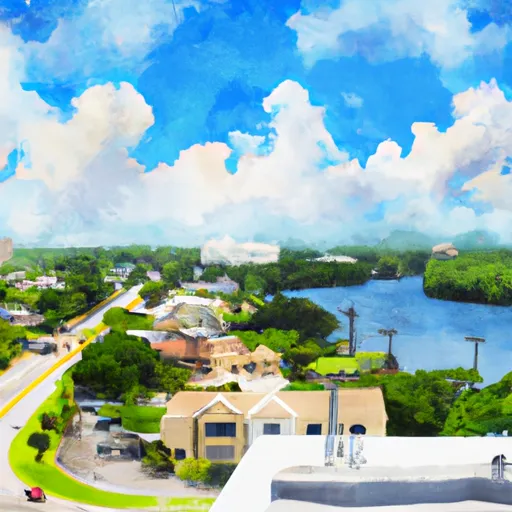-
 Snoflo Premium
Snoflo Premium
Get unlimited access to all our content
With no Ad interruptions! - Start Your Free Trial Login with existing account
Rockledge
Eden Index
Climate
6.7
•
Recreation
5.4
•
Community
2.9
•
Safeguard
5.3/10

Rockledge, Florida is a charming city located in Brevard County, on the eastern coast of the state. Known for its picturesque landscapes and warm climate, Rockledge offers a pleasant outdoor experience for residents and visitors alike. The city enjoys a subtropical climate, characterized by hot, humid summers and mild, dry winters. Summers are typically long and often experience afternoon thunderstorms, while winters are mild with comfortable temperatures.
Rockledge is blessed with abundant hydrology constituents, thanks to its proximity to the Indian River Lagoon. This vast estuary system provides various opportunities for water-based activities such as boating, fishing, and kayaking. The lagoon is home to diverse marine life, including dolphins, manatees, and a variety of fish species.
In addition to the Indian River Lagoon, Rockledge boasts numerous outdoor recreation opportunities. The city is surrounded by beautiful parks, nature preserves, and trails, offering opportunities for hiking, biking, and bird-watching. Some notable spots include Rockledge Park with its waterfront views and McLarty Park with its sports fields and playgrounds.
Overall, Rockledge, Florida is a delightful destination for nature enthusiasts and outdoor lovers, offering a favorable climate, abundant hydrology constituents, and a range of recreational activities to enjoy.
What is the Eden Index?
The Snoflo Eden Index serves as a comprehensive rating system for regions, evaluating their desirability through a holistic assessment of climate health, outdoor recreation opportunities, and natural disaster risk, acknowledging the profound impact of these factors on livability and well-being.
Climate Health Indicator (CHI): 6.7
Rockledge receives approximately
1314mm of rain per year,
with humidity levels near 88%
and air temperatures averaging around
23°C.
Rockledge has a plant hardyness factor of
9, meaning
plants and agriculture in this region tend to thrive here all year round.
By considering the ideal temperature range, reliable water supplies, clean air, and stable seasonal rain or snowpacks, the Climate Health Indicator (CHI) underscores the significance of a healthy climate as the foundation for quality living.
A healthy climate is paramount for ensuring a high quality of life and livability in a region, fostering both physical well-being and environmental harmony. This can be characterized by ideal temperatures, reliable access to water supplies, clean air, and consistent seasonal rain or snowpacks.
Weather Forecast
Streamflow Conditions
St. Johns
Area Rivers
St. Johns
Snowpack Depths
St. Johns
Reservoir Storage Capacity
St. Johns
Groundwater Levels
Recreational Opportunity Index (ROI): 5.4
The Recreational Opportunity Index (ROI) recognizes the value of outdoor recreational options, such as parks, hiking trails, camping sites, and fishing spots, while acknowledging that climate plays a pivotal role in ensuring the comfort and consistency of these experiences.
Access to outdoor recreational opportunities, encompassing activities such as parks, hiking, camping, and fishing, is crucial for overall well-being, and the climate plays a pivotal role in enabling and enhancing these experiences, ensuring that individuals can engage in nature-based activities comfortably and consistently.
Camping Areas
| Campground | Campsites | Reservations | Toilets | Showers | Elevation |
|---|---|---|---|---|---|
| Manatee Cove Military - Patrick AFB | None | 6 ft | |||
| Okee-Tantie Campground and Marina | 270 | 17 ft | |||
| Jetty Park | 150 | 9 ft | |||
| Wickham Park | 88 | 31 ft | |||
| Manatee Hammock Park | 177 | 18 ft |
Catastrophe Safeguard Index (CSI):
The Catastrophe Safeguard Index (CSI) recognizes that natural disaster risk, encompassing floods, fires, hurricanes, and tornadoes, can drastically affect safety and the overall appeal of an area.
The level of natural disaster risk in a region significantly affects safety and the overall livability, with climate change amplifying these risks by potentially increasing the frequency and intensity of events like floods, fires, hurricanes, and tornadoes, thereby posing substantial challenges to community resilience and well-being.
Community Resilience Indicator (CRI): 2.9
The Community Resilience Indicator (CRI) recognizes that education, healthcare, and socioeconomics are crucial to the well-being of a region. The CRI acknowledges the profound impact of these elements on residents' overall quality of life. By evaluating educational resources, healthcare accessibility, and economic inclusivity, the index captures the essential aspects that contribute to a thriving community, fostering resident satisfaction, equity, and social cohesion.

